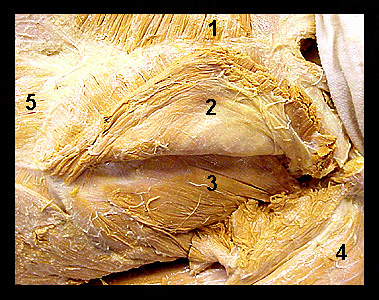|
|
||||||||||||||||||||||||||||||||||||||||||||||||||||||||||||||||||||||||
|
This image shows several chest muscles on a male human cadaver. In the human the pectoral group has two major divisions: the pectoralis major and the pectoralis minor. The pectoralis major is the large triangular muscle covering the upper part of the chest. Its action is to adduct and flex the humerus. The pectoralis minor lies directly beneath the pectoralis major. The minor is flat, thin and more slender than the pectoralis major. The pectoralis minor inserts on the coracoid process of the scapula and can function to draw the scapula forward and downward or elevate the ribs if the scapula is fixed in position. The deltoid abducts the arm and aids in flexion and extension The rectus abdominis originates from the pubis and inserts on costal cartilages 5-7 and the sternum. Contraction of the rectus abdominis compresses the abdomen and flexes the vertebral column. |
|
